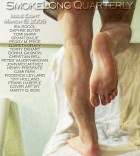Takeo Suzuki was teaching KC, big-time film actor and director, the proper way to slice yellowtail. The chef made four quick cuts. KC mimicked him, but his cuts were barbaric and loud. Takeo, his insides boiling, looked at KC—his big star shiny smile and golden face. In disgust, he threw down his Bento knife.
“No, no, no!” Takeo, enraged, shook his head, looked at his student. “I show you six times now. Six! It’s fish. You’re cutting a fucking fish for sushi! Don’t you understand?”
Takeo regretted the decision he made six months ago to help KC, who was prepping for his next film, “Sashimi”, a projected big-budget, Oscar-contending epic about an American who travels to Tokyo and becomes a master sushi chef. KC wanted to learn the ins and outs of preparing sushi and experience life as a chef.
Takeo had seen the star’s recent slew of films. “Goat Boy”, a painful epic about a pan flute idiot savant who took the world by storm. “Prohibition”, his four and a half hour snoozer about the legislative process surrounding the United States Constitution’s 18th amendment. And “The Curling Richardsons”, three hours of lunacy about the much-heralded Canadian curling team. He hated them all. And so did everyone else—they were box office bombs. So why was Takeo doing this? Fame and fortune. To gain the stature of Michiba Rokusaburo, the original Iron Chef, perhaps, and add “celebrity” to his own stature as highly acclaimed sushi chef. Or just a tv show, a book deal.
The lessons had gone horribly. They had spent two weeks longer than planned rolling sushi, and four days longer covering sushi ordering and dining etiquette. Takeo had chastised KC multiple times. He never seemed to learn. Eat an entire piece at once. The ginger is for cleansing your palate only. Eat everything on your plate. And even basic Japanese sayings. How many times had Takeo told this nitwit that Itamae-san was the proper way to address a Japanese and not akagai-san, which was a polite way to address a clam?
“Gomen nasai, akagai-san.” KC steepled his hands together and bowed to Takeo. KC dropped his knife on the floor, said “whoops!,” knelt, picked it up, wiped both sides of the blade on his shirt, returned it to the table. The dirty knife was mere millimeters away from strips of raw sea eel and red snapper.
Takeo bit his lower lip. He thought about his wife Sayuri and his eight-year-old daughter Echiko. All of this was for them. He could taste the clean cool air atop Japfu Peak. Someday he would return there. It’s all he could do not to scream, “I’m not a fucking clam,” and lunge at KC and sink his knife into his abdomen and gut him.
Sayuri had often told him, don’t let your temper get the best of you. It makes you look like raw tuna meat, she had said once, and it feeds the stereotype of the angry Japanese chef. He would get angry debating this stereotype with her. Just like his father when he was growing up. Inside their home he would become irate when talking about the United States’ bombing of Hiroshima and Nagasaki. Takeo’s uncle—his father’s brother, Hiroshi—was among the dead. He called it mass murder. Thousands incinerated, burned alive. He called the Americans murderers. Outside of the house, he never talked about it. He told Takeo not to either.
After the yellowtail butchering, KC called for a half-hour break. He walked over to his entourage of thin women with clipboards and laptops, suited men with cell phones and ledgers. At least they weren’t bothering Takeo to make sushi, as they had been, butchering the few Japanese words they had learned, like ebi, ikura, and unagi.
Takeo retreated to a chair in the corner and buried his hands. He didn’t know how he was going to get through this. In his mind he couldn’t shake the image of stabbing KC. Of slicing him, serving a uniform rectangle of his muscle or liver on a rice bed. It wasn’t food but art. He heard the pitter-patter of footsteps coming toward him. It was Echiko, running with clumsy steps. Sayuri was behind her, smiling. Takeo opened his arms.


 The SmokeLong Grand Micro Contest (The Mikey) is now an annual competition celebrating and compensating the best micro fiction and nonfiction online.
The SmokeLong Grand Micro Contest (The Mikey) is now an annual competition celebrating and compensating the best micro fiction and nonfiction online.